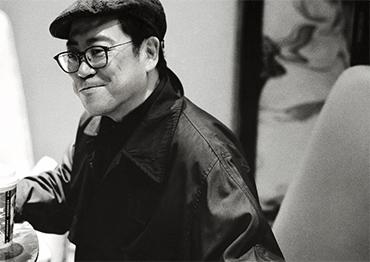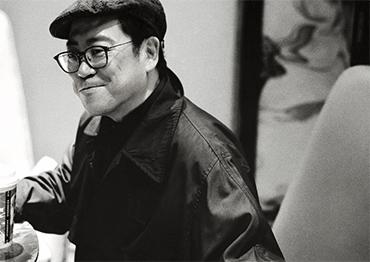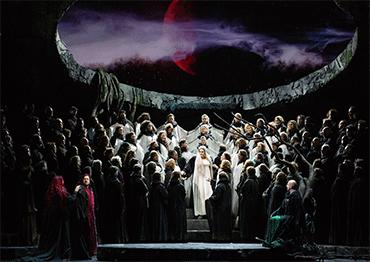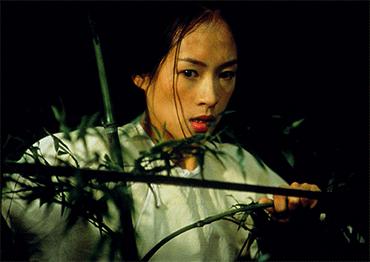Yip began to develop his aesthetics of New Orientalism as early as 1993, when he designed for the film Temptation of a Monk and the play Medea for Taiwan’s Contemporary Legend Theater. In these projects, he fused and adapted elements of Western Post-Impressionism with Chinese artistic forms.
Directed by Law Cheuk-yiu and set in the Tang Dynasty (618-907), Temptation of a Monk follows Jing-yi (Wu Hsingkuo), a monk with a troubled past, who falls in love with Qing Shou (Chen Chong), a nun – and secret assassin sent to kill him.
For Qing Shou’s costumes, Yip combined Tang styles with Victorian fashions. The film’s sets and costumes also drew from the surrealism of German artist Max Ernst and traditional Chinese mythology. He used vivid, symbolic colors like Gustav Klimt’s gold – a hue he associated with decadence, splendor and death.
For Medea, a Peking Opera adaptation of the Greek tragedy directed by Wu Hsing-kuo and set in the ancient Loulan Kingdom along the Silk Road, Yip made bold choices. He created an enormous dress for Medea, blending Renaissance styles with traditional Chinese long sleeves. He added two giant bamboo poles to the waistline, which would extend up to five meters wide when Medea’s fury reached its peak, visually representing her intense wrath.
Yip’s surrealistic designs challenged Peking Opera costume. “My costumes were considered unorthodox and eccentric at the time,” he said.
“When Peking Opera actors wore them, they had to rethink their performances to fit both traditional opera and these unconventional costumes. This contrast led to lots of unexpected artistic effects on stage.”
In 1996, Yip was invited to design costumes for Rashomon at Austria’s Bühnen Graz Opera House – his first international theater project. Directed by Taiwanese choreographer Lin HwaiMin, the opera adapted Japanese author Akutagawa Ryunosuke’s classic short story from 1915 about scruples and survival in feudal Kyoto.
Yip merged Japanese Noh theater styles and Kabuki-inspired makeup with medieval European court fashion. “The fusion of classical Japanese clothing with European court styles made everything so natural and convincing,” Yip explained.
Since then, Yip has been a prominent figure in the international theater scene, collaborating with celebrated artists like British choreographer Akram Khan, American director Robert Wilson, Italian-born Belgian director Franco Dragone, and director François Girard.
“I shed narrow nationalistic views, embrace all kinds of culture, absorb as much as I can and then return to my roots,” Yip writes in Autobiography. “This way, I’ve developed brand new understanding and creative attitudes toward Chinese culture and other cultural systems worldwide.”
His experiences have shaped his concept of New Orientalism – a vision that illuminates Chinese history and culture.
In Crouching Tiger, Hidden Dragon, he created a poetic martial arts world set in the Qing Dynasty (1644-1911). For Feng Xiaogang’s The Banquet (2016), Yip designed a Hamlet-inspired palace in 10th century China, and recreated grand battles from the Three Kingdoms period (220-280) for John Woo’s war epic Red Cliff (2008). Most recently, in Creation of the Gods Ⅰ: Kingdom of Storms (2023), he crafted a visually stunning world of mythology and fantasy set in the Bronze-Age Shang Dynasty (1600- 1046 BCE).
For Yip, New Orientalism is about “opening a door” to explore Eastern traditions. “This concept shouldn’t be defined by the West,” he asserted in Aesthetics. “We need to reclaim the narrative definition and define ourselves.”
Yip argues that China’s enduring culture provides endless inspiration for creating a contemporary culture of global significance.
“My understanding of New Orientalism is about evolving from our traditions and turning the past tense to the present tense,” he said.

 Old Version
Old Version


